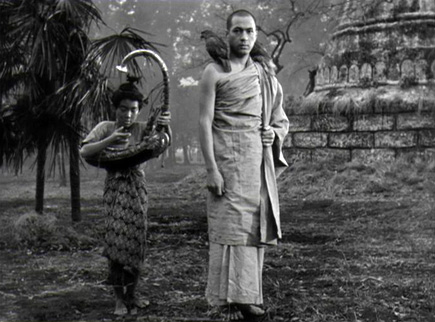Sunday, 23 September 2012
1,001 Films: "The Burmese Harp" (1956)
Kon Ichikawa's The Burmese Harp is a Japanese World War II story, filmed not long after the fact, which initially seems to be framed as a musical, as though only through song might the nation's wounds be addressed, and maybe healed. A harp-clutching prisoner of war being held in Burma is dispatched to help the English talk down a Japanese platoon who've holed up in the mountains after the official surrender. The negotiations go badly, and everyone winds up dead save the POW, who's merely injured, and taken in at a nearby monastery. Back at prison camp, our hero's comrades wonder if they've seen the last of him - but then they notice a monk who appears outside the prison gates every day to hear their choral practice.
To be Buddhist about it (and, as one of the monks points out, "Burma is the country of Buddha"), it's no surprise that the POW and the monk turn out to be the same man - what's important, as a mid-film flashback illustrates, is the journey he took to get there. Our hero steals a monk's robes to ensure his own safe passage, but encounters such suffering en route (piles of corpses scattered on hillsides, washed up on beaches) that the garments come to confer a spirituality upon this previously boyish harpist: too alienated by all he's witnessed to return to his troop, he instead feels compelled to bury the dead, single-handedly.
You can see exactly why it struck a chord: the POW is a potent symbol of everything 50s Japan was still trying to do, chiefly settle its debts and move on. A Western film in this vein - the notable The Best Years of Our Lives, say - would surely have been tempted by the easy sentiment inherent in the set-up, but Ichikawa instead pursues a pared-back approach closer to the period's Mizoguchi films (the mute monk may as well be a ghost), which makes tremendously moving even the potentially absurd business of the soldiers communicating through parrots: these are men who, faced with the unspeakable, retreat into silence, unable to talk to one another directly.
Solace is instead located in the landscape - ageless and enduring, in Minoru Yokoyama's outstanding cinematography - and from ritual and ceremony: it's one of the great films about statues, and what they stand for. To Western eyes, The Burmese Harp continues to be nothing less than revelatory: the Japanese equivalent of our ongoing band-of-brothers projects, it suggests that these men not only fought together but sang together, surrendered together, died together and were buried together, and that something consoling, even ennobling, could be found in this.
The Burmese Harp is available on dual-edition DVD and Blu-Ray through Eureka.
Subscribe to:
Post Comments (Atom)

No comments:
Post a Comment